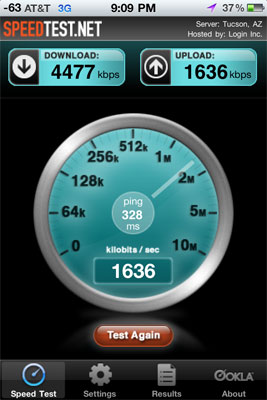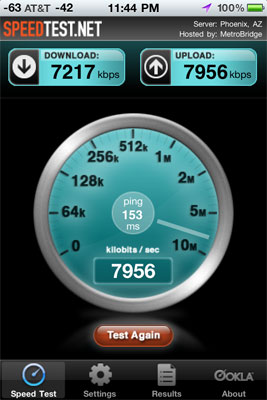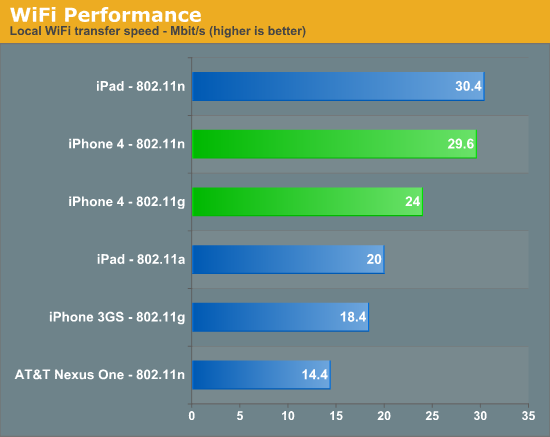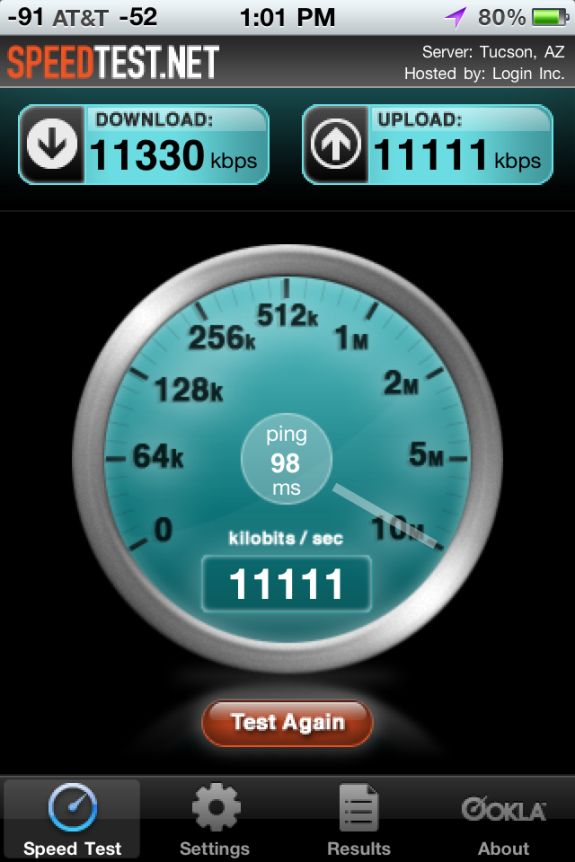Apple's iPhone 4: Thoroughly Reviewed
by Brian Klug & Anand Lal Shimpi on June 30, 2010 4:06 AM EST- Posted in
- Smartphones
- Apple
- iPhone 4
- Gadgets
- Mobile
Network Improvements
The iPhone continues to be an AT&T exclusive in the US. With the iOS 4 upgrades the iPhone 4 supports tethering over Bluetooth or USB. The feature is an extra $20 per month on top of your existing iPhone data plan and it also deducts bandwidth from the 2GB you get with the data plan. It's not a coincidence that AT&T timed the release of its iPhone tethering option with the move away from unlimited data plans. You don't have to give up your existing unlimited data plan if you don't want to, however if you want to enable tethering you have to sign up for the new $25/2GB plan.
I'm not a huge fan of iPhone tethering right now because despite paying for the service and having full signal strength on AT&T, I'm getting horrible transfer rates while trying to upload this article. I had to sign up for airport WiFi to get it live, thanks AT&T. When it does work however, it works well. As you'll see later you can easily get multiple Mbps out of AT&T's network in areas with good coverage. That easily equals the lower end of what you'd see from WiMAX today. As I've mentioned before however, it's really hit or miss with AT&T. The network is either great or totally unusable, while its competitors are generally more consistent but never quite as fast. I'd say that there's a good chance Apple will bring the iPhone to Verizon, it's just a matter of when.
| Cost of Ownership Comparison | |||||
| AT&T iPhone 4 | Sprint EVO 4G | Verizon HTC Droid Incredible | |||
| Cost of Device | $199 w/ 2 year contract | $199 w/ 2 year contract after $100 MIR | $199 w/ 2 year contract | ||
| Plan with 900 Minutes, Unlimited SMS/Data | $104.99/mo, unlimited SMS, 2GB data | $99.99/mo, unlimited SMS, unlimited data, 4G | $109.98/mo, unlimited SMS, unlimited data | ||
| Tethering | + $20/mo | + $29.99/mo | + $25/mo* | ||
| Total Monthly + Tethering | $124.99/mo | $129.98/mo | $134.98/mo | ||
| Total Cost of Ownership over 2 Years | $2718.76 | $2598.76 after $100 MIR | $2838.52 | ||
| Total Cost of Ownership over 2 Years w/ Tethering | $3198.76 | $3318.52 after $100 MIR | $3438.52 | ||
AT&T's plans are actually reasonably priced if you don't go over the data limits. A $15/mo data plan will get you 200MB of transfers per month and $25 will give you 2GB. For users like my parents the 200MB option is great. Even for me personally, 2GB is fine. I tend to peak at 700MB per month, but that's because at the office I'm almost always on my desktop or connected via WiFi. It's unclear how tethering is going to change this for me. Our own Brian Klug on the other hand easily pushes more than 2GB of transfers per month. So AT&T's rate switch is either going to save you a few bucks per month or make you really unhappy.
The iPhone 4 brings HSUPA class 6 for upload speeds of up to 5.76 megabits/s to the platform. This is a 15 fold improvement over the 384 kilobits/s maximum of the iPhone 3G and 3GS, which I routinely see. Not all AT&T markets are updated to HSUPA, and in practice I saw uploads of around 1.5 megabits/s, in line with class 2 or class 3 HSUPA.
Downstream HSDPA speeds remain unchanged from the 3GS, supporting up to 7.2 megabit/s HSDPA. I'm lucky since my market is HSDPA 7.2, as I routinely see speedtests of 5 megabits/s or above very late at night when there isn't very much plant load. I haven't seen any measurable increase in speeds over the 3GS, except in locations with very low signal as noted before.

My fastest iPhone 4 speedtest so far
Even Anand in one of the slowest 3G cities in the US saw significant improvements with the iPhone 4. AT&T's network in general seems to be improving. While the best he'd been able to achieve was around 1Mbps a year ago, these days he can break 2.5Mbps down during the evenings.

iPhone 4 speedtest in Raleigh, NC
WiFi speeds have also improved, as Apple has added 802.11n in the 2.4 GHz band. 5 GHz support remains absent, something which would have likely complicated antenna design even further. Interestingly enough, the BCM4329 WiFi and Bluetooth SoC does contain 802.11a 5 GHz support, the reason it's disabled is again likely due to antenna design constraints. The Broadcom SoC also includes an FM tuner and transmitter, though support for either remains and sadly (given Apple's historical lack of FM radio support) will remain such. Bluetooth 2.1 EDR is there as well.
The iPhone 4 seems to connect at 802.11n rates of 72 megabits/s in best case, far from the maximum without channel bonding of 150 megabits/s. This is still a welcome improvement from the 802.11b/g in the iPhone 3GS, which seemed to never connect above b rates in practice. As an aside, mobile devices using 802.11b rates (modulated using DSSS) are a huge contributing factor to WiFi congestion at conferences - I've even seen DSSS modulated rates (and thus 802.11b devices) explicitly disallowed from connecting to APs at conferences. It's a welcome improvement to see iPhone bringing N support.

A typical WiFi test result
However, even on my 25/4 DOCSIS 3 cable connection, I could only squeeze out a maximum of 8.5 megabits/s down and 8.0 megabits/s up while connected at 72 megabits/s best case. This was using the speedtest.net app to a local test location. I tried with an Airport Extreme (new generation), a WRT600N running DD-WRT, and a WRT54GL-TM running Tomato. All three showed similar results capping out around 8 megabits/s down when I could run tests in excess of 30 megabits down on my desktop. This is probably more of a CPU bottleneck appearing than anything else.
Update:
I thought there was something wrong with my WiFi performance, turns out the iPhone 4 is indeed faster than a palty 8 megabits/s. ;)
There were a number of comments by folks who were able to run speedtest.net and get throughput above 10 or 11 megabits/s. Testing earlier today on a much faster connection, I managed to get something in line with their numbers:
Early today, the folks at DigitalSociety also managed to get much faster WiFi speeds in the neighborhood of 20 megabits/s, way higher than my meager 8 megabits/s. To do so, they loaded an MP3 in safari stored on a local webserver and watched network utilization. I wish I had thought of this, because it's perfect. In the past, the speedtest.net app always used to saturate my connection over WiFi. My only explanation is that the application performs slower over WiFi in iOS 4 than it did in iOS 3, something Anand noted as well. Thanks for all the heads up messages, everyone!
I set up a similar test to DigitalSociety's. I opened an 85 MB PDF stored on my local web server in the browser of each device and watched network utilization using bwm-ng. I tested with an Airport Extreme connected over gigabit to my webserver with no other network utilization. I took the average of 5 runs on the iPad, iPhone 4, iPhone 3GS, and my AT&T Nexus One running Froyo 2.2 (which is 802.11n). The results are much, much more in line with earlier expectations.

The iPhone 4 comes close to but can't quite best the iPad, though the difference is minimal. I did notice that the iPad associates at the same 72 megabits/s connection speed as the iPhone 4. Thankfully, the iPhone 4 easily bests the iPhone 3GS. Finally, although the AT&T Nexus One associates at an 802.11n rate of 65 megabits/s, it's slower than the iPhone 3GS. I have a feeling the device is writing the PDF into flash, whereas the iOS devices are loading it into memory.











270 Comments
View All Comments
Thorvald - Wednesday, June 30, 2010 - link
I understand that you aren't trying to stab at iOS4, but some of these really seem to be a stretch. For example, the iPhone 3G is just about two years old. What two-year old Android phone is running the latest OS with full feature parity as brand-new phones?I am quite sure that someone (with more time on their hands than me) could come up with an equally long list of points where Android falls short of iOS4, especially if we are going to be nitpicky about it.
It would be more nice if there were ways to objectively measure quality of user experience. Specific features are something that can be listed, but implementation counts too.
Spoelie - Wednesday, June 30, 2010 - link
You have to understand that that list was NOT originally compiled as a comparison to Android but was the negative part of a "what can you expect with this upgrade" (positives vs negatives) list. The iOS4 upgrade is offered on the 3G and that's why the point has merit: what does the upgrade mean for 3G users?However I concur it can read as a comparison since most of these points are Android features on SOME phones (social networking integration for example is mostly part of the proprietary custom UIs like HTC Sense and TouchWiz and not part of Android itself).
Personally, since I do have an Android phone, it reads more like a "what would I miss if I made the switch" list. But only some of the points.
darwinosx - Wednesday, June 30, 2010 - link
Thats a really idiotic list composed by someone who knows nothing about iPhones.-Anyone who wants flash on a mobile device is not paying attention.
-Comments on IOS4 on the 3G are silly. Especially since Apple says its not supported except on the 3GS and 4. Funny how they don't comment on how many Android phones are still on 1.6 and will never be upgraded including some pretty new phones.
-"True' multi-tasking? I don't think they understand how Android multi-tasking works. It's certainly not "true" multi-tasking as on a desktop os. It's also highly inefficient and a major cause of poor Android phone battery life.
-Android phones have widgets, which are intrusive and resource consuming because the stock Android OS UI is so awful.
-There are plenty of ways to USB mass storage with the iPhone.
-You can mass mark e-mails as read.
-There are plenty of ways to access the file system not that 99% of users will ever want to.
-You don't need vibration feedback when touching the screen because the iPhone screen, unlike many Android phones, actually reacts easily to touch.
-You can do bluetooth file transfers.
-SMS/MMS has multiple delivery notifications.
-I play Xvid and Divx all the time and there are multiple third party apps for that.
-You can add to the iPhone from other apps including Double Twist and others.
Truly an idiotic list.
bplewis24 - Wednesday, June 30, 2010 - link
Whether or not the list is idiotic, you just solidified your own standing with this post. I'm not sure why I even bothered posting to such an idiotic retort.Brandon
mesiah - Thursday, July 1, 2010 - link
lmao, not to sound like an android fanboy, or even an apple.... haterboy (hmmm new term there.) But your reasoning for alot of those missing features just further backs up the apple fan stereo type.Any time an apple device lacks a feature its because "That feature is not needed.' "That feature is useless." or how about "Anyone who wants ___ isn't paying attention."
But when the next gen phone comes out, and it finally does have those features. You know, the ones everyone else already had and you said you didn't need. You know, like... a camera. You then talk about how your new feature reinvents the phone its self. How "no one has ever done it like apple did."
Seriously, its pathetic. I know every phone out there has flaws. I also know there are plenty of things apple gets right with the iphone. I will even go as far to admit that smart phones wouldn't be where they are today if it weren't for the iphone. But you people need to admit when you are missing features you should obviously have simply because the all knowing Steve doesn't think you need them. But then again, coming from a company that can admit no wrong, even when their products have a serious design flaw such as the new antenna issue, I can't really expect the followers to act any differently than the ceo.
"If you want flash you aren't paying attention. If your reception went through the basement you don't know how to hold a phone. And if the AT&T network sucks its because you and all the other people are actually trying to use it."
strikeback03 - Thursday, July 1, 2010 - link
One of my friends on facebook posted a screenshot of one of iOS4's great new features......you can change your wallpaper. Really?
bregalad - Wednesday, June 30, 2010 - link
-There are two main reasons to keep Flash off mobile devices: battery life and mouse-overs, a commonly used Flash feature that doesn't work on a touch OS. Given the choice between incomplete support for a resource intensive plug-in and all-day usefulness I'll take that all-day battery life.-Multitasking approaches still up for debate
-iOS 4 runs slowly and lacks features on older hardware - agreed, but does Android do any better? Does your carrier even allow you to upgrade your OS or do you have to get a new phone?
-Given how much battery life iOS 4 stole from me I really wish there were quick toggles
-I don't live in any social network. I rarely even launch the facebook app.
-Something akin to home screen widgets would be very nice
-Every iPhone and iPod touch has the same sounds, it's terrible in an office with lots of them.
-Agreed on the mass marking as read
-Access to the file system is another thing Apple is philosophically opposed to. The iPhone is supposed to be an appliance not a computer.
-Early iPods had disk mode which was very useful. I wish Apple wouldn't be so inflexible.
-You want tactile feedback and all day battery life? Maybe next decade.
-File transfers assumes you have access to the file system and aren't trying to transfer DRM'd files. Not going to happen.
-I don't know about you, but I've never needed to mass delete contacts from any phone or computer. Do you suffer from multiple personality disorder?
-Better notifications of all types would be welcome.
-Smart dialling would be a good feature addition
-An app whose sole purpose is to play "illegally" downloaded files. Yeah, Steve's going to approve that one 'real soon now'.
-The dependency on iTunes is a philosophical one. Steve believes your computer is your digital hub, that it contains the master copy of all your stuff. By definition your phone, with its limited storage capacity, contains a subset of that data. I think that makes sense for the vast majority of the public. You're a niche Apple doesn't want to deal with.
Griswold - Wednesday, June 30, 2010 - link
Must be nonsenseday today.And before you say it, yes I got a 3G and I will replace it with a i4 when they're available around here instead of an android phone as I originally planned, but for other reasons than the fictional ones you just stated.
Bateluer - Wednesday, June 30, 2010 - link
Agreed, there are several Android phones that are out now that offer parity with the iPhone 4, and several within 2 months of release that will handily surpass it.As usual, Anand's reviews were very well written and detailed, but I'll still pit my year old Moto Droid against any iPhone product. :p
JAS - Wednesday, June 30, 2010 - link
As Anand pointed out in his review, the Google/Android operating system feels more like using a computer; and the iPhone (iOS 4) operating system feels more like an appliance. The Android OS is apt to appeal more to the geek than to the "normal mainstream consumer," just as Microsoft Windows is a favorite of people who like to tinker with their computers.For better or worse -- each person has to make their own judgment -- Apple's products are defined as much by features that are purposefully withheld as by the cool innovations that are added.